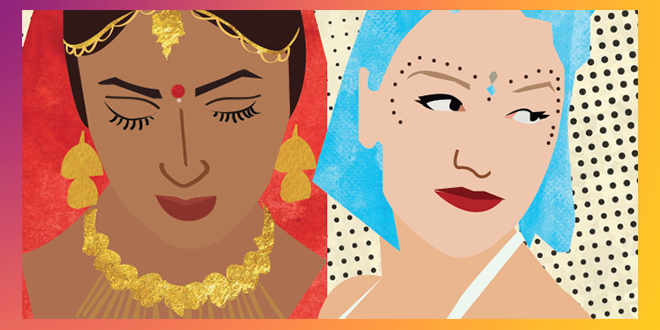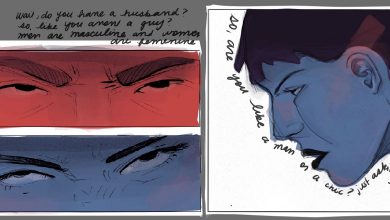Feminism 101: What is Cultural Appropriation?

Illustration by Jenny Dodge.
Halloween came and went this year and left a slew of tasteless Halloween costumes in its wake, the most controversial being the mocking of #NODAPL protesters. While many can understand why people took offense in the #NODAPL costumes, people seem to fall into different judgement camps when it comes to celebrities dressing up as calaveras or donning historically problematic costumes like Hilary Duff and her boyfriend did when they went as a sexy pilgrim and a Native American.
But what’s the big deal about impersonating historical figures? Isn’t dressing up as a calavera celebrating Mexican culture? Why do people make such a fuss about Halloween costumes if it’s a ripped off Celtic holiday in the first place? Many of these questions are asked by skeptics of cultural appropriation. They tend to dismiss the outrage that surrounds these costumes as “oversensitive,” or sometimes even take offense at someone’s being offended. But the truth is, this mindset is ignorant, hypocritical, and inherently disrespectful to the cultures being appropriated. Not many understand what cultural appropriation means or how it differentiates from cultural exchange.
Cultural appropriation is a centuries-old practice of disrespecting a culture by adopting aspects of that culture without regarding the significance of those aspects. These cultures typically belong to non-white peoples and the aspects stolen are usually religious or symbolic, such as the Indian bindi or the Native American feathered war bonnet. Appropriation most commonly happens when people from Eurocentric cultures steal from another culture without respecting or understanding the meaning behind what they stole. The exchange is not mutual and usually only benefits the Eurocentric culture at the expense of the other culture, as evidenced by the Halloween costumes mentioned earlier.
Other questions that arise when discussing cultural appropriation involve scenarios in which the opposite happens. Why is a white person not allowed to wear dreadlocks, but a black person can wear a hairstyle that mimics a white person’s hair texture? Let’s think about white culture versus black culture; was it ever discussed if white hair textures were considered professional? While hair color is a frequent topic of discussion, most Eurocentric hair textures are considered normal. Unfortunately, many black people feel pressured to change their natural hair texture in an attempt to conform to Eurocentric cultural standards. This is why black people and most other people of color are rarely accused of appropriating culture, because Eurocentric ideals dictate what is acceptable. And when this society implies that a certain hair texture or style is not professional, conforming becomes a survival method, not a statement. For this reason, it is absurd to imply that Eurocentric culture is oppressed and being appropriated when in fact it has been the dominant culture that has been appropriating other cultures for years.
For the skeptics still wondering why the “politically correct” are not outraged at the cultural appropriation of Halloween, that’s because it originates from the Celtic holiday Samhain. The Celts are from modern-day Ireland, the United Kingdom, and northern France. Want to take a wild guess as to what area those countries belong to? That’s right, they’re European (yes, the UK is still considered a Eurocentric region despite Brexit). Therefore, Halloween is not typically considered cultural appropriation because Celtic culture is not seen as subordinate to Eurocentric cultures the way Native American or Mexican cultures are.
Now, instead of complaining about people “overreacting” about appropriation, be aware of cultural exchange and become familiar with it. Cultural exchange is everything appropriation is not — in the sense that the exchanging of cultural aspects is mutual. Writer Jarune Uwujaren gave a fantastic example of cultural exchange. In her example, her sister’s groom (a white man) donned traditional Nigerian garb for the wedding. He was not “stealing” the clothing; rather he was invited by the Nigerian family to wear the clothing. He respected the gesture and wore the clothing as a way to connect to his new Nigerian family. As Uwujaren notes, “If he…treated it as exotic or weird or pretended he now understood what it means to be Nigerian and refused to wear Western clothes ever again – the experience would have been more appropriative.”
The lesson you should take away from this example: engage with other cultures, don’t just take from them. Understand those cultures and respect them, and if you truly find meaning in an aspect of that culture, give credit where it’s due.




